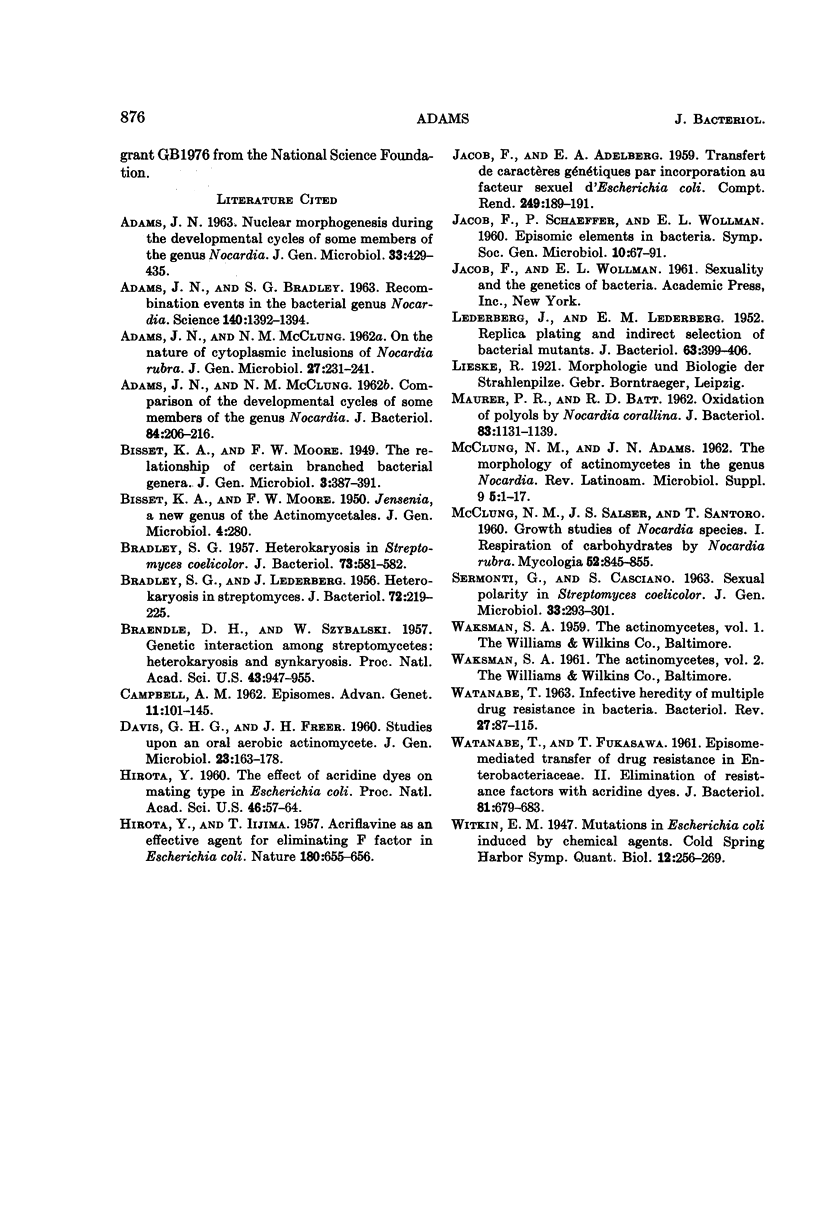Abstract
Adams, James N. (University of South Dakota, Vermillion). Recombination between Nocardia erythropolis and Nocardia canicruria. J. Bacteriol. 88:865–876. 1964.—Nutritionally complementary auxotrophic mutants derived from Nocardia erythropolis did not yield prototrophic recombinants when progeny from mixed cultures or newly mixed strains were inoculated onto minimal medium. Similarly, complementary auxotrophic mutants of N. canicruria did not produce prototrophic recombinants. When interspecific mating was attempted between complementary mutants of N. erythropolis and N. canicruria, prototrophic recombinants were recovered at frequencies dependent, in part, upon the auxotrophic strains used in the test crosses. Growth of the parental types in mixed cultures was necessary for the production of recombinant progeny. Direct selection for recombinants by inoculating the selective medium with a mixture of parental types without prior mixed growth did not result in the recovery of recombinants. Varying the medium upon which mixed growth occurred, or varying the ratio of N. erythropolis to N. canicruria cells used as inocula, did not greatly affect the recovery of recombinants. Heat-killing one or the other of the parental types prevented recombinant production. The lack of recovery of recombinants from crosses of homologously derived strains suggested that a mating factor controls recombination. The mating factor was not eliminated by acriflavine treatment. The recovery of a recombinant strain capable of forming recombinants with either N. erythropolis or N. canicruria, and the recovery of another strain which mated only with N. erythropolis in backcrosses, suggests that the mating factor may be of a multiple nature.
Full text
PDF











Selected References
These references are in PubMed. This may not be the complete list of references from this article.
- ADAMS J. N., McCLUNG N. M. Comparison of the developmental cycles of some members of the genus Nocardia. J Bacteriol. 1962 Aug;84:206–216. doi: 10.1128/jb.84.2.206-216.1962. [DOI] [PMC free article] [PubMed] [Google Scholar]
- ADAMS J. N. NUCLEAR MORPHOGENESIS DURING THE DEVELOPMENTAL CYCLES OF SOME MEMBERS OF THE GENUS NOCARDIA. J Gen Microbiol. 1963 Dec;33:429–435. doi: 10.1099/00221287-33-3-429. [DOI] [PubMed] [Google Scholar]
- Adams J. N., Bradley S. G. Recombination Events in the Bacterial Genus Nocardia. Science. 1963 Jun 28;140(3574):1392–1394. doi: 10.1126/science.140.3574.1392. [DOI] [PubMed] [Google Scholar]
- BISSET K. A., MOORE F. W. Jensenia, a new genus of the actinomycetales. J Gen Microbiol. 1950 May;4(2):280–280. doi: 10.1099/00221287-4-2-280. [DOI] [PubMed] [Google Scholar]
- BRADLEY S. G. Heterokaryosis in Streptomyces coelicolor. J Bacteriol. 1957 Apr;73(4):581–582. doi: 10.1128/jb.73.4.581-582.1957. [DOI] [PMC free article] [PubMed] [Google Scholar]
- BRADLEY S. G., LEDERBERG J. Heterokaryosis in Streptomyces. J Bacteriol. 1956 Aug;72(2):219–225. doi: 10.1128/jb.72.2.219-225.1956. [DOI] [PMC free article] [PubMed] [Google Scholar]
- Braendle D. H., Szybalski W. GENETIC INTERACTION AMONG STREPTOMYCETES: HETEROKARYOSIS AND SYNKARYOSIS. Proc Natl Acad Sci U S A. 1957 Nov 15;43(11):947–955. doi: 10.1073/pnas.43.11.947. [DOI] [PMC free article] [PubMed] [Google Scholar]
- DAVIS G. H., FREER J. H. Studies upon an oral aerobic actinomycete. J Gen Microbiol. 1960 Aug;23:163–178. doi: 10.1099/00221287-23-1-163. [DOI] [PubMed] [Google Scholar]
- HIROTA Y., LIJIMA T. Acriflavine as an effective agent for eliminating F-factor in Escherichia coli K-12. Nature. 1957 Sep 28;180(4587):655–656. doi: 10.1038/180655a0. [DOI] [PubMed] [Google Scholar]
- Hirota Y. THE EFFECT OF ACRIDINE DYES ON MATING TYPE FACTORS IN ESCHERICHIA COLI. Proc Natl Acad Sci U S A. 1960 Jan;46(1):57–64. doi: 10.1073/pnas.46.1.57. [DOI] [PMC free article] [PubMed] [Google Scholar]
- JACOB F., ADELBERG E. A. Transfert de caractéres génétiques par incorporation au facteur sexuel d'Escherichia coli. C R Hebd Seances Acad Sci. 1959 Jul 6;249(1):189–191. [PubMed] [Google Scholar]
- LEDERBERG J., LEDERBERG E. M. Replica plating and indirect selection of bacterial mutants. J Bacteriol. 1952 Mar;63(3):399–406. doi: 10.1128/jb.63.3.399-406.1952. [DOI] [PMC free article] [PubMed] [Google Scholar]
- MAURER P. R., BATT R. D. Oxidation of polyols by Nocardia corallina. J Bacteriol. 1962 May;83:1131–1139. doi: 10.1128/jb.83.5.1131-1139.1962. [DOI] [PMC free article] [PubMed] [Google Scholar]
- SERMONTI G., CASCIANO S. SEXUAL POLARITY IN STREPTOMYCES COELICOLOR. J Gen Microbiol. 1963 Nov;33:293–301. doi: 10.1099/00221287-33-2-293. [DOI] [PubMed] [Google Scholar]
- TRAUTMAN R., BREESE S. S., Jr Isodensity ultracentrifugation of foot-and-mouth disease virus in caesium chloride. J Gen Microbiol. 1962 Feb;27:231–239. doi: 10.1099/00221287-27-2-231. [DOI] [PubMed] [Google Scholar]
- WATANABE T., FUKASAWA T. Episome-mediated transfer of drug resistance in Enterobacteriaceae. II. Elimination of resistance factors with acridine dyes. J Bacteriol. 1961 May;81:679–683. doi: 10.1128/jb.81.5.679-683.1961. [DOI] [PMC free article] [PubMed] [Google Scholar]
- WATANABE T. Infective heredity of multiple drug resistance in bacteria. Bacteriol Rev. 1963 Mar;27:87–115. doi: 10.1128/br.27.1.87-115.1963. [DOI] [PMC free article] [PubMed] [Google Scholar]


